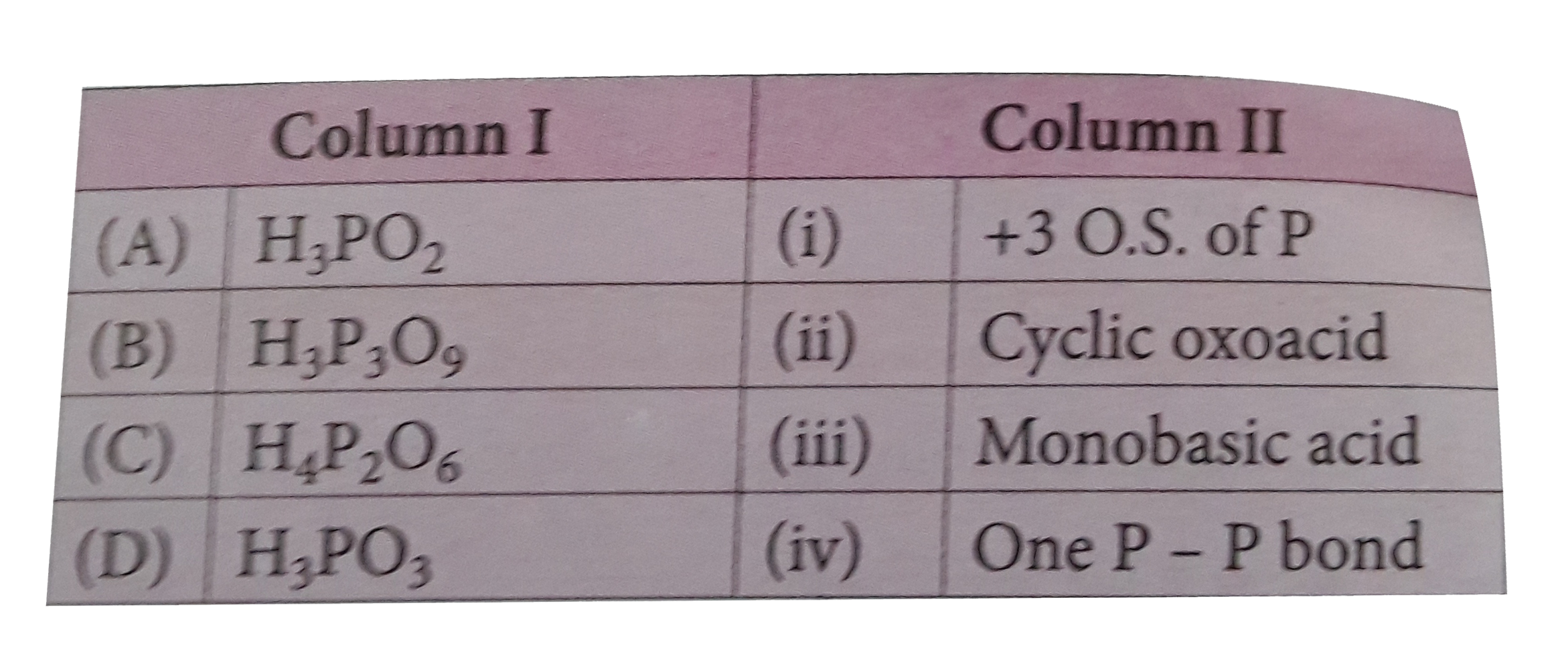Match the column I with column II and mark the appropriate choice.
Column IColumn II(A)C2H2(i)sp3d2 hybridisation(B)SF6(ii)sp3d3 hybridisation(C)SO2(iii)sp hybridisation(D)IF7(iv)sp2 hybridisation
(A)→(i),(B)→(iii),(C)→(ii),(D)→(iv)
(A)→(iii),(B)→(i),(C)→(iv),(D)→(ii)
(A)→(ii),(B)→(iii),(C)→(i),(D)→(iv)
(A)→(iv),(B)→(i),(C)→(iii),(D)→(ii)
The correct Answer is:B
To solve the problem of matching the compounds in Column I with their corresponding hybridization states in Column II, we will analyze each compound step by step.
1. Identify the Hybridization of IF7 (Iodine Heptafluoride):
- Iodine (I) has 7 valence electrons.
- It forms 7 bond pairs with 7 fluorine atoms and has no lone pairs.
- The hybridization can be determined as follows:
- Total orbitals involved = 1s + 3p + 3d = 7 orbitals.
- Therefore, the hybridization of IF7 is sp³d³.
2. Identify the Hybridization of SF6 (Sulfur Hexafluoride):
- Sulfur (S) has 6 valence electrons.
- It forms 6 bond pairs with 6 fluorine atoms and has no lone pairs.
- The hybridization can be determined as follows:
- Total orbitals involved = 1s + 3p + 2d = 6 orbitals.
- Therefore, the hybridization of SF6 is sp³d².
3. Identify the Hybridization of SO2 (Sulfur Dioxide):
- Sulfur (S) has 6 valence electrons.
- It forms 2 bond pairs (double bonds with oxygen) and has 1 lone pair.
- The hybridization can be determined as follows:
- Total orbitals involved = 1s + 2p = 3 orbitals.
- Therefore, the hybridization of SO2 is sp².
4. Identify the Hybridization of C2H2 (Ethyne):
- Each carbon (C) has 4 valence electrons.
- In C2H2, each carbon forms 2 bond pairs (one with another carbon and one with hydrogen) and has no lone pairs.
- The hybridization can be determined as follows:
- Total orbitals involved = 1s + 1p = 2 orbitals.
- Therefore, the hybridization of C2H2 is sp.
Matching the Columns:
Now we can match the compounds from Column I with their respective hybridization states from Column II:
- A (C2H2) matches with (iii) sp hybridization.
- B (SF6) matches with (i) sp³d² hybridization.
- C (SO2) matches with (iv) sp² hybridization.
- D (IF7) matches with (ii) sp³d³ hybridization.
Final Matching:
- A → (iii) sp
- B → (i) sp³d²
- C → (iv) sp²
- D → (ii) sp³d³
Answer:
The correct option is B.
- Iodine (I) has 7 valence electrons.
- It forms 7 bond pairs with 7 fluorine atoms and has no lone pairs.
- The hybridization can be determined as follows:
- Total orbitals involved = 1s + 3p + 3d = 7 orbitals.
- Therefore, the hybridization of IF7 is sp³d³.
- Sulfur (S) has 6 valence electrons.
- It forms 6 bond pairs with 6 fluorine atoms and has no lone pairs.
- The hybridization can be determined as follows:
- Total orbitals involved = 1s + 3p + 2d = 6 orbitals.
- Therefore, the hybridization of SF6 is sp³d².
- Sulfur (S) has 6 valence electrons.
- It forms 2 bond pairs (double bonds with oxygen) and has 1 lone pair.
- The hybridization can be determined as follows:
- Total orbitals involved = 1s + 2p = 3 orbitals.
- Therefore, the hybridization of SO2 is sp².
- Each carbon (C) has 4 valence electrons.
- In C2H2, each carbon forms 2 bond pairs (one with another carbon and one with hydrogen) and has no lone pairs.
- The hybridization can be determined as follows:
- Total orbitals involved = 1s + 1p = 2 orbitals.
- Therefore, the hybridization of C2H2 is sp.
Now we can match the compounds from Column I with their respective hybridization states from Column II:
- A (C2H2) matches with (iii) sp hybridization.
- B (SF6) matches with (i) sp³d² hybridization.
- C (SO2) matches with (iv) sp² hybridization.
- D (IF7) matches with (ii) sp³d³ hybridization.
- A → (iii) sp
- B → (i) sp³d²
- C → (iv) sp²
- D → (ii) sp³d³
The correct option is B.
Topper's Solved these Questions
- CHEMICAL BONDING & MOLECULAR STRUCTUREBOOK - NCERT FINGERTPS ENGLISHCHAPTER - CHEMICAL BONDING & MOLECULAR STRUCTUREEXERCISE - HIGHER ORDER THINKING SKILLS
10 Videos
- CHEMICAL BONDING & MOLECULAR STRUCTUREBOOK - NCERT FINGERTPS ENGLISHCHAPTER - CHEMICAL BONDING & MOLECULAR STRUCTUREEXERCISE - EXEMPLAR PROBLEMS
14 Videos
- CLASSIFICATION OF ELEMENTS AND PERIODICITY BOOK - NCERT FINGERTPS ENGLISHCHAPTER - CLASSIFICATION OF ELEMENTS AND PERIODICITY EXERCISE - Assertion And Reason
15 Videos
Similar Questions
Knowledge Check
Match the column I with column II and mark the appropriate choice.
Column IColumn II(A)Fe(OH)3(i)Ksp=s2(B)Ag2CrO4(ii)Ksp=27s4(C)CH3COOAg(iii)Ksp=108s5(D)Ca3(PO4)(iv)Ksp=4s3A(A)→(iii),(B)→(ii),(C)→(iv),(D)→(i)B(A)→(ii),(B)→(iv),(C)→(i),(D)→(iii)C(A)→(i),(B)→(iii),(C)→(ii),(D)→(iv)D(A)→(iv),(B)→(i),(C)→(iii),(D)→(ii)Match the compounds given in column I with oxidation states of carbon given in column II and mark the appropriate choice.
Column IColumn II(A)C6H12O6 (i) +3(B)CHCl3 (ii) -3(C)CH3CH3 (iii) +2(D)(COOH)2 (iv) 0A(A) → (iv), (B) → (iii), (C) → (ii), (D) → (i)B(A) → (i), (B) → (ii), (C) → (iii), (D) → (iv)C(A) → (ii), (B) → (iii), (C) → (iv), (D) → (i)D(A) → (iii), (B) → (ii), (C) → (i), (D) → (iv)Match the Column I with column II and mark the appropriate choice.
Column IColumn II(A)Coal gas(i)CO+H2(B)Synthesis gas(ii)CH4(C)Producer gas(iii)H2+CH4+CO(D)Natural gas(iv)CO+N2A(A) → (i), (B) → (ii), (C ) → (iii), (D) → (iv)B(A) → (iii), (B) → (i), (C ) → (iv), (D) → (ii)C(A) → (iv), (B) → (iii), (C ) → (ii), (D) → (i)D(A) → (i), (B) → (iii), (C ) → (i), (D) → (iv)
sp3d hybridisation has
View SolutionMatch the column
Column−IColumn−II(a)C2H2(P)sp3dhybridisationSO2(Q)sp3hybridisation(c)I−3(R)sp2hybridisation(d)NH+4(S)sphybridisation
View SolutionMatch the complexed listed column −I with type of hybridisation listed in column −II and select the correct answer using the code given below the lists :
Column−IColumn−II(a)[AuF4]−(p) dsp2hybridisation(b)[Cu(CN)4]3−(q) sp3hybridisation(c)[Co(NH3)6]3+(r) sp3d2hybridisation(d)[Fe(H2O)5NO]2+(s) d2sp3hybridisation
View SolutionMatch the column I with column II and mark the appropriate choice.
Column IColumn II(A)Borax(i)Na3AIF6(B)Inorganic benzene(ii)Na2B4O7.10H2O(C)Cryolite(iii)AI2O3.2H2O(D)Bauxite(iv)B3N3H6
View SolutionMatch the column I with column II and mark the appropriate choice
Column IColumn II(A)Borax-bead(i)Alum(B)Inorganic benzene(ii)Diborane(C)Antiseptic(iii)Metaborate(D)Bridged hydrogens(iv)Borazine
View Solution

